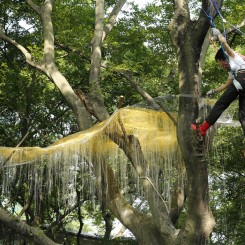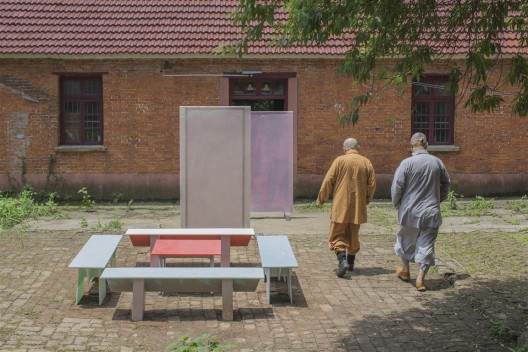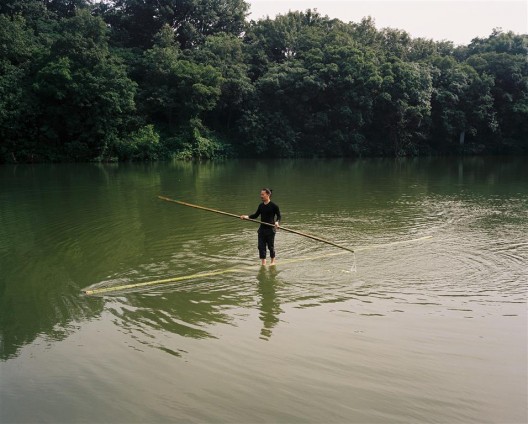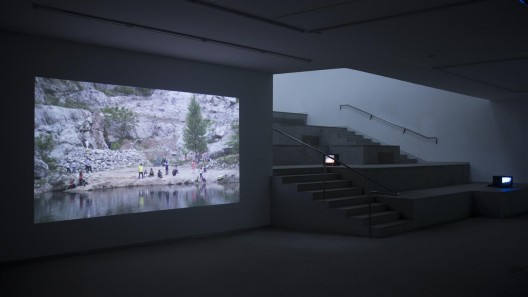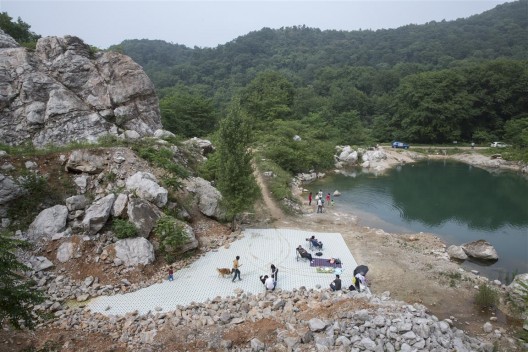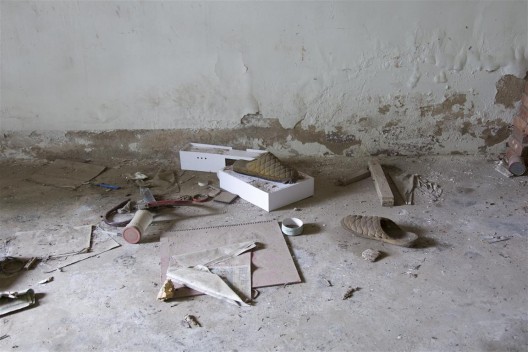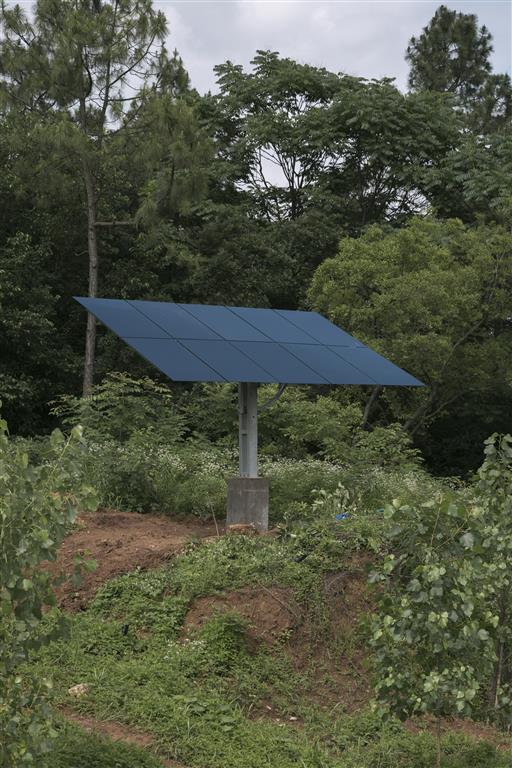This piece is included in Ran Dian’s print magazine, issue 4 (Winter 2016–2017)
Editor’s note: What can we make of topography or “writing a place” as a way to think about “locality” and site? This topic is apt considering the rich geological layers in the former capital city of Nanjing, a two-hour drive from Shanghai. More specifically, at the Sifang Art Museum in the Laoshan mountains (hence the title “Museum Sites: Views of Laoshan”; in Chinese, “Shan-zhong Meishuguan”, or “A Museum in the Mountains”), what can the curators of this prominent private art museum in China accomplish? The curator at Sifang Art Museum, Liu Lin, a local curator, Wang Yamin, and Ran Dian’s Sang Tian sat down for a chat. Here are excerpts from Liu Lin’s responses.
Liu Lin’s statement: The “Topography Project” was planned with four rounds, two of which have been realized. The first part, “Qilin Stall”, concerned local tombs in Nanjing; it touched on issues like death, the soul/spirit, and ancestral worship, as well as something on the his-tory of art from the West spreading in the East. We have always been paying close attention to these things from such a history of cir-cumstances and experiences that have piled up, layer upon layer, together with their present state in China. Tombs were first and foremost among them.
The second part, “Mountain Site: View of Laoshan”, was more concerned with Sifang Art Museum and how it relates to the mountainous region where it is located. By the time we reached this second part, the focus had somewhat shifted. We left the art museum behind and went into the mountains, where we’ve got something of the shape and stance from inside and outside the white box. I call it a “corporeal” exhibition—with the artists’ physiological state at the threshold of the limits of the space, the relation between humans and the locality in the “Mountain Site: Views of Laoshan” is rendered more intense.
The third part, which we will be preparing for, is the “Capital Plan of Nanking”, based around a text that the Nationalist (KMT) government issued about building a new capital, in 1928. The focus will be on the texts of this project itself, the history and current reality of urban planning in Nanjing, as well as the question of modernity in China at an earlier period. This project is conducted with a healthy dose of skepticism, particularly with regards to whether this “early modern period” in China ruptured or continued.
The final part, “Green Stream” (Qingxi), refers to an ancient river in Nanjing from the Jin to Tang dynasties [circa 265–907 AD]. It gradually silted up afterwards and turned into a subterranean waterway. Although it had long disappeared, the river repeatedly featured in poetry, lyrics, and myths and legends, and was often included in literary citations about historic events by scholars in later generations.
Unlike the three preceding parts, this last part looks at the title itself—the green stream is more of a symbol, symbolizing a mellow river meandering through worldly existence. This project may help you dispel the sense of history by thrusting you into the river of time, leaving you there, and breaking down the barrier to times past. It is designed as an end point for the four parts, much like a stronghold or an anchor—and so this is how the “Topography Project” is organized.
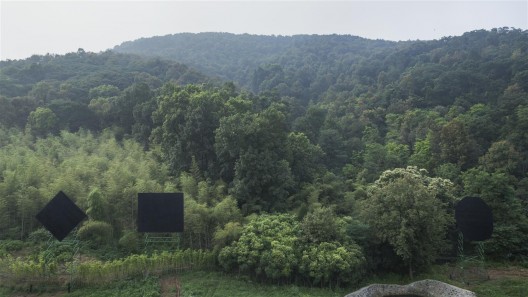
艺术家刘韡最早曾于2008年展出的作品《暗物质》,在“山中美术馆”特定场所中重现。/ The work by Liu Wei, “Dark Matter”, which first appeared in 2008, makes a site-specific reappearance in “Mountain Sites: Views from Laoshan.”
1
Sang Tian: For this exhibition, we have seen a 110-page Introduction to Mountain Site: Views of Laoshan, a volume of Supplementary Material, a catalogue on the first part of the entire project, “Qilin Stall”, as well as a catalogue on the “Annals of Laoshan”, which is the part you are working on now. Do the planned documents, four in total, constitute the textual framework for the Topography Project?
Liu Lin: These are just some of the textual materials we have so far. Apart from the Annals of Laoshan which is still in the works, and that previous Handbook on Qilin—indeed a small handbook, with fairly limited materials serving as a “study kit” displayed on site—the other two publications do not really represent the focus of the project, but rather merely as background information on the project. Though not all projects have such lengthy proposals before being launched, we thought it wouldn’t hurt as references. I think it’s a speedy entry into the concept of the “Mountain Site: Views of Laoshan”. I don’t expect artists to develop an interest in such an out-of-the-way mountainous region without any introduction from me. Since over half a year’s worth of prior research had been done at the museum, we organized what we had for the artists’ reference. Those two documents, by and large, are an introduction to Laoshan’s geography, historic evolution, and current state, as well as its fauna and flora, cultural relics, local myths and beliefs, and so on. Moreover, there are some archival material taken from The Unofficial History of Jiangpu (Jiangpu Baisheng) and The Gazetteer of Jiangpu (Jiangpu Diminglu)—essentially small encyclopedias about the region. Based on the practical needs of the exhibition, we have singled out twenty to thirty sites to be included in the background information to help artists with a general impression.
In this project, having the body roam the space makes the texts more appealing. I’m afraid some of the earlier texts were really about Wang Yanjun and I roaming “bodily”. When artists arrive on site, to some extent, they are continuing this kind of work and experience. There hasn’t been any core literature for the Topography Project. I suppose it is not time to summarize all this just yet. We are still in the exploratory phase—such explorations have been going on for two years now.
2
“Insert the individuals into the nooks and crannies of history”, and “Speaking specifically on an imaginative archaeology and the writing of history is the necromantic means to achieve this goal.” These two quotes are from the first part of the Topography Project, “Qilin Stall”. Are they specific topographic methods? As the catalogue for “Qilin Stall” notes: why choose “tombs” rather than the urban-rural “exurb” fringe reasons for the choice of tombs as a subject, but not of the rural-urban fringe? Let us talk about this a bit: what exactly is this concept of “topography” you are proposing?
“Imaginative archaeology and historical writing” are a topographic method, but they are more of a concrete method specifically for the “Qilin Stall” project. We certainly did not create “topography”, which is really something from geology and more often discussed in the field of architecture (Ed: Sifang is probably among the first to raise topographic methods within the realm of contemporary art). The original Greek term conveys the meaning of “place-writing”. In topography, we can continually draw the outline of a place, writing almost endlessly and intensely about a place. As an art project, we cannot think of any other way to name it, and so we directly borrowed the term “topography”.
Naming the project “topography”, a term with strong academic connotations, could sometimes lead to the misperception that we are applying a fixed strategy to face our subject of study; as a matter of fact, my definition of topography has always been shifting—I have had lots of fun with this. If we have to sum things up, this is where it stands: First, it involves the shape of a land; second, it concerns the circumstances as well as certain connections entailed in this land; third, it indicates the human situation in relation to the land. To me, anything dealing with these three aspects—shape, circumstances, and human-land relationships—becomes a subject of interest for topography. During each round of this project, we selected a spatial subject—first, tombs, and then this old forest on the mountain—followed by surveys of people, events, and things in each of these spaces. The forms of the survey range from archival research to on-site visits, casual discussions, speculation, and imagination—nothing is off-limits. We do not go by any one particular topographic method; it is a whole set of modes of thinking around how to perceive space. The ways that came to a particular mode of thinking con-stantly change, too. On any given day, all kinds of possibilities for the particular method were available.
3
Place-writing? You also mentioned going into Laoshan to explore and look for the appropriate “site”—here do you refer to the “space” in the sense of Yi-Fu Tuan’s human geography? How do you define “space”? Why “here”, but not “there”? What do you think artists’ criteria for selecting sites are?
The “space” I mentioned earlier is not intended to have any special meaning, and may be somewhat simplistic. It is an object that awaits to be written about, or at least it is an object that can be written about. At the time of selection, the notion of “here, but not there” was also based on the possibility that it can be written about—although this was not completely accurate from the perspective of “topography”, as these sites are supposed to be totally equal. Selecting here but not there is sometimes simply a matter of feasibility; looking back now, this mode of safe thinking hindered the project’s development on another level. Nevertheless, to implement such a plan at a privately run art museum like Sifang, these issues are inevitable. Of course, we wanted to do whatever we could, but the situation is just the reverse. When we adopt an attitude completely counter to the system of art museums, sometimes we cannot achieve anything. In fact, we are fighting a lonely battle, like a novice in a dark, dense forest. It is only natural to make concessions at times in order to achieve results. I suppose there are some artists who are just like me. Though they see it as a great opportunity to come into the mountains and chew over the state of artworks in a site that is not an exhibition space, in the end they still compromise over “feasibility”. It is very difficult to generalize these artists’ criteria for their selection of sites—for some, their artworks by nature do not fit the outdoor setting, so they feel out of place in the wild from the outset; for others, it is the opposite, as in the case of Tang Dixin’s walk in mountains and forests as well as his aquatic projects. Moreover, the artists’ habitual creative impulses are bound to be given important consideration. A case in point is Wang Wei, who selected an industrial relic that resembles the view in a mountain-and-river landscape scroll painting. Another example is Yu Ji. Her working method is normally based on prolonged observation and research, and so for this somewhat rushed project, she just chose a site that was “non-exhibition-space” in very general terms. I don’t, however, believe these sites are unique; rather, they are chance occurrences, just like the random incidents in everyday life. The interesting things we encountered probably only make up an infinitesimal portion “what Laoshan is”—but at the very least we have this tiniest of portions, which is better than absolutely nothing.
4
The three aspects of your topographic method are supposed to be quite clearly defined. But in terms of artistic methodology, how do you differentiate the architectural planning from ways of doing field research in anthropology and sociology? Where do they differ?
As things stand now, these three aspects are distinct. But this can never be certain—regarding the definition of “topography”, we each have our own interpretation. In my own case, the focus of attention would vary at different points; my stamina, mood, or luck at any given moment would have some bearing on that. Compared with the methods of architectural planning and those of anthropological and sociological field research, what we use is a less stringent research method that relies more on experience; the results of our research and field study are not as important as what we experience during this process. We cannot really dress up our field work to such a degree as to call it “field research”; let’s just call it “topographic sauntering”. Actually, there is a retro flavor in this, sort of like the way the classical Chinese literati and scholar-officials integrated research, arts, and life into a unified whole. My hope is that “topography” can be relatively loose as a methodology, but it has to be an organic whole as a mode of “self-governance”.
During our conversation last time, you mentioned “good governance”, i.e. governance through peregrinations by scholar-officials, which is different from the colonial concept of Historia Naturalis in that, in the scholar-officials’ travelogues, indulgent excursions coexist with earnest sincerity and reverence. Such personalized tours can still be a means to good governance. I agree with your point that it would be ideal if they obtained the real gist of biopolitics from their journeys, but that is pretty difficult. This exhibition seldom touches upon politics. Yet the political predicament we have encountered during the implementation of the plan becomes a mockery to ourselves. In a domain that appears to possess only natural attributes, we have been forced into the entanglement of disputes over the rights to use the site. Although such an occurrence is nothing unusual in today’s China, it has taken up so much of our energy. Sometimes you get confused about who is subject to governance and who is governing, and you don’t know which category you actually belong in. In our wrestle with the government, villagers, and local bullies and rogues, our curatorial team becomes the most disadvantaged and vulnerable group. Perhaps this can also be seen as a symbol of the shattering of contemporary elitist imagination.
The exhibition about Laoshan should, even to the smallest extent, make the Laoshan region a “better” place. For instance, among our concrete methods, the research on Laoshan’s soil and vegetation “ought to” become an agronomic model. Our prior project that paid attention to tombs is also partially related to the basics of geoscience; our “Capital Plan of Nanking” and research on China’s early modernity are also concerned with a specific case study of “Spaces of Hope” (after David Harvey’s book published in 2000). As you will see, in the Topography Project, I often note “humans” and “human-land relationships”—if such relationships transcend the limits of individual practice, they will become one of the ways to achieve universal good governance; then why not go ahead with it? Though I have no such confidence, I still hope—and hope that it can start with one’s own practice. The problem is, in the current era, what you will have to confront above all else is probably the failure of self-governance. To discuss collective good governance—the types of “good” politics and approaches—under the premise of such failure is pretty illusive. It will be a feat if we can accomplish good governance within the exhibition itself. This probably will be the difference this project can make in the curatorial system.
5
What exactly is the “failure in self-governance” that you will have to face above all else? Self-governance and collective governance are supposed to take place simultaneously, aren’t they? Do you have to follow the sequence of “cleaning your own room first before expecting a clean world”? What do you mean by a difference in the curatorial system?
Failure in self-governance can be understood in a literal sense—how well have you managed your own life? My sense is that few people are able to manage their own lives well. Take myself as an example: I have experienced anguish during this exhibition, despite my constant hope to deem this anguish a bodily meditation and exaggerate its romantic nature, which is obviously self-deceiving. I did not practice what this exhibition calls “peregrination” to its fullness myself—that is precisely a failure in self-governance. Self-governance and collective governance can still be simultaneous. Someone who understands governmentality is not necessarily a happy person; he could well be indifferent, cruel, and tempestuous—perhaps. I talked about the issue of “subjectivity” in the past. In the current era, our subjectivity is all too strong. Everyone is full of individuality, but without some solid bond between such individualities, you will never be able to assemble these people. I am probably a bit conservative. But before the image of a collectivistic “person” returns, I do not hold high hopes for a proposal of the “simultaneity of self-governance and collective governance”.
The difference in the curatorial system I referred to can be detected in this exhibition, albeit only subtly. The bodily anguish I just mentioned can be seen in the artists and in all the participants of this project. Nevertheless, we have shared our enjoyment of such anguish. Conversely, artists have shared with us their Eureka moments. The planning, criticism, and creation are mutual here—a plan can be vetoed, and the veto can in turn be overridden. Thus, at the same time, I feel I am optimistic here—at least we still have control over this project, and have a grip on the specific condition of these people who are involved in self-governance. Nonetheless, this is still a kind of internal governance, an experiment.
6
Some hold the view that that logic in Tuan Yi-fu/Edward W. Soja/Henri Lefebvre/David Harvey has become a prominent “model opposition” in terms of idea and a symbol of political correctness at |present, when the real estate sector has become the primary driver of China’s economic growth. Almost every architect or planner can concoct some fancy-sounding phrases to show they are apt and au courant. Nowadays, any discussion of locality tends to turn into an accomplice of real estate and tourism development. Has your topography project de facto become such an accomplice, whether you like it or not?
If it is only for showing off, there is really nothing to talk about in the way of thinking. It is necessary, though, to seriously discuss the theories of these thinkers you mentioned—“space” should become a fundamental question for philosophical deliberation, and should be viewed as an important approach at any time. Lefebvre said before him there was no philosophy of space. But now it exists, which is a good thing.
I absolutely hope to demolish those ugly real estate projects. But are there any alternative plans after their demolition? I think the real estate or tourism projects that are able to apply such spatial theories or ways of thinking as “topography” are definitely much better than those built on a vast expanse of wilderness. Those spurned plans by Le Corbusier and Minoru Yamasaki are currently very much the reality in China; perhaps this would be the alternative. The architectural space of each era is invariably an ideological battlefield—if you win in one aspect, you lose in another. The Nationalist architecture in Nanjing built by the government in the 1930s and 1940s is magnificent. At first glance it looks very solid, too, but it proved financially unfeasible over time. What’s even worse was that the government that supported the construction was unable to sustain its own power structures. I think the small restaurant next to my home has done a decent job with their metal signboard explaining the origin of “Siweitou”, the name of the neighborhood where it is located. And then there are those real estate developers who have the state of mind to sift through the annals of the locale and figure out the history of the land they have acquired—they still have their own charm.
About writer
Liu Lin is a curator and writer who lives and works in Nanjing. Liu is Chief Curator at Sifang Art Museum and one of the main instigators of the on-site programs “Qilin Stall” and “Mountain Sites: Views of Laoshan” at Sifang Museum.
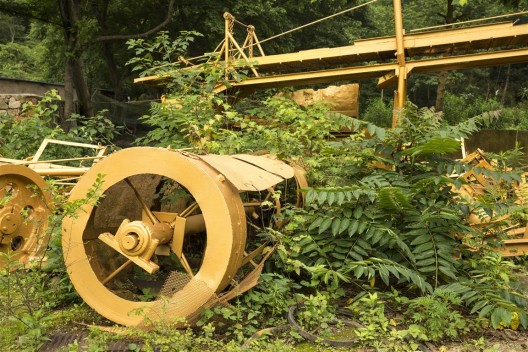
《金光采矿区》局部。艺术家将这些遍布铜锈的庞大机械全部喷成金色,成为郑国谷近年颇多讨论的能量学试验场。/ Part of the “Golden Mining Field”. The artist painted these huge rusted machines in gold—a site of experimentation for Zheng Guogu’s research on energy fields.
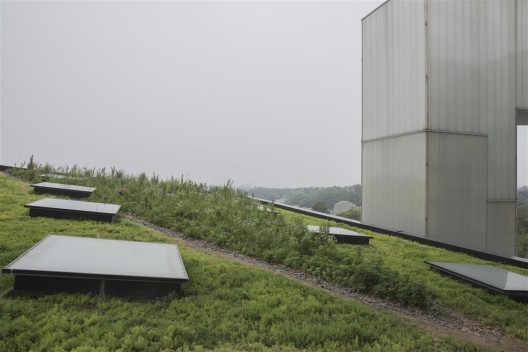
位于四方当代美术馆楼顶花园的《稊地》项目(艺术家郑波)。/ The “Weed Plot” project by Zheng Bo, located on the rooftop of the Sifang Museum.
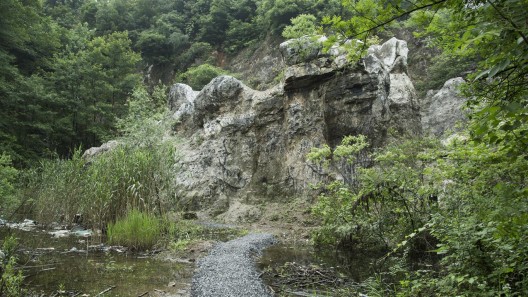
艺术家陈翊朗在一个小宕口的石壁上创作了名为《山灵之主》的壁画。/ The artist Oscar Chan Yik Long created a mural entitled “The Lord of the Mountain” on a small opening on the rock face.
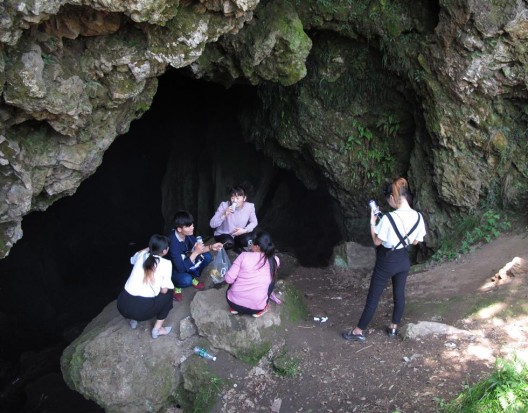
L Sub(白双全、胡敏仪、严瑞芳)目击到老山本地人在龙洞上午餐的场景(上图),这一场景成为参展项目《金核桃四重奏》的起点。/ L Sub (Pak Sheung Chuen + Wo Man Yee Wendy + Yim Sui Fong) came upon locals from Laoshan lunching at the Dragon Cave, which became the starting point of the participatory project “Golden Walnut Quartet.”
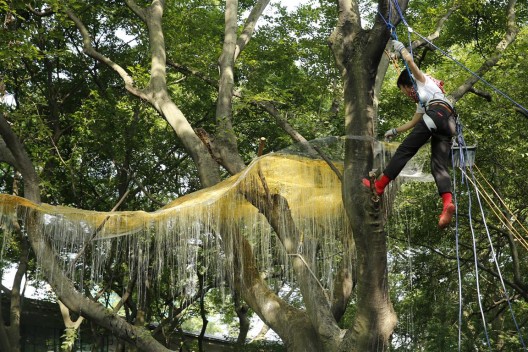
艺术家于吉在项目开幕当日的表演(劳动现场),这件名为《练习曲—慢板 乐章Ⅲ》的作品位于四方当代艺术湖区里的一颗朴树上。/ The performance by the artist Yu Ji on the opening day. The work “Etudes—Lento III” was located at a Chinese hackberry true on the lake of the Sifang area.

